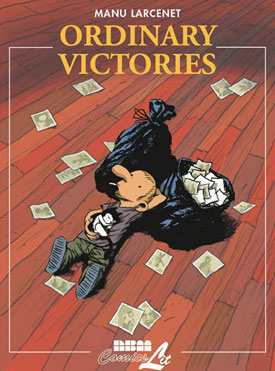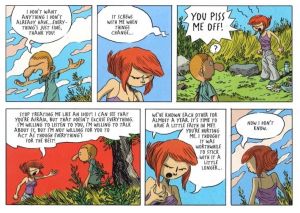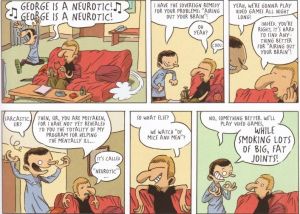- Comics
- Comics Reviews
- Manga
- Comics Reviews
- European Comics
- News
- Comics News
- Press Releases
- Columns
- Spotlight
- Digital Comics
- Webcomics
- Cult Favorite
- Back Issues
- Webcomics
- Movies
- Toys
- Store
- More
- About
By Andy Frisk
July 8, 2010 - 22:17
Marco is a young man on a voyage of discovery. He is constantly learning new things about life, love, relationships, jobs, politics, and himself. His course in life is not an easy one, much like it isn’t for most of us, but Marco has the added burden of having a severe anxiety disorder, or panic attacks as he calls them. Throughout the amount of time we spend with Marco, his life and outlooks change, grow and in some cases mature. Along the way we learn a great deal about life in general and relationships specifically. These relationships are strained by economic, romantic, political, artistic, and mental problems and promises. In the end it is not only Marco who has learned many new things about life and the relationships that comprise it, we as readers have learned a great deal about the power of sequential art to uniquely convey some really poignant ideas and emotions in this wide reaching and widely themed work of art.
 |
As mentioned, Marco suffers from debilitating panic attacks. His condition though doesn’t direct the narrative of Ordinary Victories. His anxiety disorder is another aspect of his life that simply contributes to who he is and serves as another conduit into understanding life, and Marco’s in particular. Yes, his disorder does directly affect his life, but it does not preclude him from living a productive life socially or romantically. So while a look at Ordinary Victories through the literary themed lens of how mental health (Marco’s father has Alzheimer’s) and anxiety disorders can affect those afflicted, it is not the graphic novel’s overriding theme.
As mentioned also, Ordinary Victories uses the theme of politics in order to illustrate Marco’s journey. Marco’s modest country house is bordered by several acres of land owned by a pretty obviously right wing minded fundamentalist type who adores hunting and is nearly always seen armed. He insists that Marco stay off his land and that “You talk to me right!” Marco stresses over the re-election of the right wing president and rails against conservatives. When he learns that one of his ailing father’s friends from the ship yards (where Marco’s father worked most of his life) voted conservative though, he gains a new understanding of the fears that drive some to conservative politics. Again, Ordinary Victories has enough politically themed episodes to warrant a political, post-colonial, new historical or even Marxist critique of it, but political themes do not solely drive the narrative either.
 |
Marco’s relationship with Emily, his long term love, is a wonderful exploration of romantic relationships and gender relations. The give and take necessary in any relationship is very well explored, as is the fear of change serious relationships inspire. As we follow Marco and Emily on their journey from new acquaintances to full time cohabitating couple, we see (as Marco learns) a perfect example of the challenges and triumphs that are birthed of such relationships. Finally, Ordinary Victories, with its focus on relationships very easily lends itself to a critical examination of the work through the lens of gender or relationship criticism. Once again though, relationship themes, while perhaps the strongest themes in the work, do not comprise what the entire work is about.
Marco and his brother both recreationally (and responsibly) use (not abuse) marijuana. Marco develops a friendship with one of his neighbors, an elderly and sage gentleman who Marco shares some real quality time with, but ends up terminating his friendship with based upon the man’s questionable and controversial actions as a military commander in World War II. Examining Ordinary Victories through the thematic lens of the pros and cons of recreational drug use or the theme of acceptance and change are both likewise valid ways to approach this graphic novel, but as already seen, not the only definitive way to analyze it.
 |
Ordinary Victories is one of those rare types of works that covers many varied themes and ideas, yet smoothly and effortlessly weaves them together. Much like life itself, which is comprised of many varying events, relationships, illnesses, political beliefs, and jobs (profoundly, Marco is a pretty renown photographer), Ordinary Victories is comprised of such. When a work can lend itself to multiple interpretations and critical approaches, it is often hailed as being literary. Some of the greatest works of literature in history such as Moby-Dick, Paradise Lost, and The Scarlet Letter, etc are open to multiple interpretations and critical approaches. While Ordinary Victories isn’t necessarily on par with these works, it is a unique work of (and amongst) sequential art.
It is the type of sequential art that simultaneously defines and demonstrates its literary qualities. Larcenet’s pencils aren’t overly realistic or detailed. They do not realistically reflect the gritty “slice of life” realism that the narrative does. The artwork does visually convey though the emotional import of the story. Marco’s features are exaggerated, but this exaggeration sets him apart as unique. His most unique physical feature is his nose which is quite long and extended. Interestingly, it forms an insight into his character. Marco often doesn’t “see much further than his nose”—a metaphor for being short sighted and a bit self-centered. Marco definitely is both of these things to a certain degree. If Marco can only see “no further than his nose,” he nevertheless can see pretty far metaphorically since his nose is so long visually and cartoonish-ly. It’s a bit of a crude metaphor, but is striking in its originality. Marco is self-centered, but definitely not selfish.
Perhaps the most powerful images in Ordinary Victories are those surrounding Marco’s panic attack episodes. The panels that illustrate the scenes become shaded totally in dark red and black. Marco’s features become sketchy blurs. These panels very powerfully and graphically communicate the stifling suffocation that Marco experiences mentally, physically, and emotionally while suffering through the effects of such an anxiety attack. It is the unique power of sequential art, as utilized by Larcenet, to convey such powerful emotions and leave it up to the reader to complete or at least meet Larcenet halfway in the creative process. The reader must visually interpret and then apply Larcenet’s portrayal of a panic attack episode to their understanding of what the visual clues of coloring and sketchiness of physical detail imply. Sequential art such as is applied in Ordinary Victories combines the power of visual art (drawing, painting, and coloring) with the power of prose to produce a unique experience.
So, Ordinary Victories is definitely worthy of being published under NBM’s Comics Lit moniker. It is more than just literature though. It is a work that helps to define what is meant by “comics lit” in the first place. Ordinary Victories is approachable from many thematic and critical angles, and is an example of the finest use of sequential art available. It’s one of those types of works that is capable of “tying up grad students for weeks” in interpretive exercise just as it is one of those types of works that can be enjoyed for its power and beauty, much like the ordinary victories of life that the work celebrates can be.
Rating: 10 /10